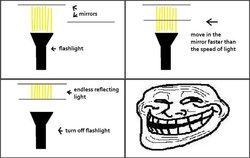Troll - 1
Classical Mechanics
Level
pending
 Is it possible to have something like this!
Is it possible to have something like this!
- Picture is not original, taken from internet
- Read picture from top left to right , similar to the next Row
Only at the height = height of earth's Radius
No
Yes only at sun
yes
Only at moon
This section requires Javascript.
You are seeing this because something didn't load right. We suggest you, (a) try
refreshing the page, (b) enabling javascript if it is disabled on your browser and,
finally, (c)
loading the
non-javascript version of this page
. We're sorry about the hassle.
The top right picture is wrong because mirrors have polish on one side so the light cannot pass through it.It is opaque from one side.